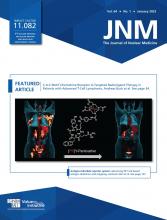Visual Abstract
Abstract
Growing interest in PSMA imaging using [68Ga]- or [18F]-labeled ligands and PSMA-based radioligand therapy (RLT) of prostate cancer (PCa) prompted us to survey the global community on their experiences and expectations. Methods: A web-based survey was composed to interrogate areas specific to PET imaging, the clinical value chain, and RLT applications. International responses were collected in early 2022. In total, over 300 valid responses were received and evaluated. Results: Most responses (83%) were given by nuclear medicine specialists with extensive experience in PET. At 22% of sites, PCa ranked “top” in cancer-type–specific PET indications, with an average and median of 15% and 10% of all cases, respectively. The most frequently used PSMA PET tracers were [68Ga]PSMA (32%) and [18F]PSMA-1007 (31%). Users reported a steady growth in PSMA PET and RLT over the past 5 y, averaging 50% and 82%, respectively, with a further 100% median growth projected over the next 5 y. Of note, more respondents indicated cognizance of personalized dosimetry than actually used it routinely. The most commonly identified barriers to future growth in PCa theranostics were radiopharmaceutical supply, reimbursement, staff availability, and buy-in of medical oncologists. Conclusion: Despite enthusiasm, this survey indicates variable adoption of PSMA imaging and RLT globally. Several challenges need to be addressed by the medical community, authorities, and patient advocacy groups in integrating PSMA-targeted theranostics into personalized medicine.
Footnotes
Guest Editor: Todd Peterson, Vanderbilt University.
Published online Aug. 11, 2022.
- © 2023 by the Society of Nuclear Medicine and Molecular Imaging.








